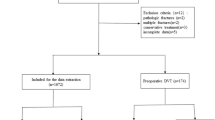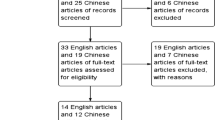Abstract
Purpose
Deep venous thrombi (DVT) and pulmonary emboli (PE) are common complications in hip fracture patients. It is imperative that orthopaedists know the patient risk factors for DVT and PE, including if type of surgery plays a role. To this end, we used the American College of Surgeons National Surgical Quality Improvement Program (ACS NSQIP) database to identify significant risk factors.
Methods
From the 2006–2011 ACS NSQIP database, 27,441 patients with hip fractures were identified using a Current Procedural Terminology (CPT) code search. DVT and PE complications, type of surgery based on CPT code, patient demographics, medical comorbidities and operative factors were identified for each patient. Fisher’s exact tests were used to (1) determine if rates of DVT and PE significantly differed based on type of surgery and (2) identify significant associations between patient factors and development of DVT/PE. These significant factors were then used as covariates in multivariable analysis to determine which risk factors predicted postoperative DVT/PE.
Results
Of the 27,441 hip fracture patients, 449 (1.6 %) developed DVT/PE. There was a significant difference in rates of DVT/PE based on surgery (p = 0.015): patients undergoing intramedullary nailing of inter-/peri-/subtrochanteric femoral fractures had the highest rates of DVT/PE (2.06 %). After multivariate analysis, renal failure and recent surgery were significant risk factors for DVT/PE.
Conclusions
This study was the first to show through large, multicentre, prospective data that type of hip fracture surgery impacts rates of DVT/PE. We further identified two additional risk factors orthopaedists should be aware of. Knowing these risk factors will help in peri-operative planning to reduce complications.


Similar content being viewed by others
References
Dixon J, Ahn E, Zhou L, Lim R, Simpson D, Merriman EG (2015) Venous thromboembolism rates in patients undergoing major hip and knee joint surgery at Waitemata District Health Board: a retrospective audit. Intern Med J 45:416–422
Zhao JM, He ML, Xiao ZM, Li TS, Wu H, Jiang H (2014) Different types of intermittent pneumatic compression devices for preventing venous thromboembolism in patients after total hip replacement. Cochrane Database Syst Rev 12:CD009543
Kim YH, Kulkami SS, Park JW, Kim BS (2015) Prevalence of deep vein thrombosis and pulmonary embolism treated with mechanical compression device after total hip arthroplasty. J Arthroplasty 30:675–680. doi:10.1016/j.arth.2014.11.004
Migita K, Bito S, Nakamura M, Miyata S, Saito M, Kakizaki H et al (2014) Venous thromboembolism after total joint arthroplasty: results from a Japanese multicenter cohort study. Arthritis Res Ther 16:R154
Fujita Y, Nakatsuka H, Namba Y, Mitani S, Yoshitake N, Sugimoto E, Hazama K (2014) The incidence of pulmonary embolism and deep vein thrombosis and their predictive risk factors after lower extremity arthroplasty: a retrospective analysis based on diagnosis using multidetector CT. J Anesth 29:235–241
Beyer-Westendorf J, Bogorad V, Tautenhahn I, Marten S, Schellong S (2013) Predictors of deep venous thrombosis in patients admitted to rehabilitation clinics after major orthopaedic surgery. Vasa 42:40–49
Alaia MJ, Patel D, Levy A, Youm T, Bharam S, Meislin R, Bosco Iii J, Davidovitch RI (2014) The incidence of venous thromboembolism (VTE)—after hip arthroscopy. Bull Hosp Jt Dis (2013) 72:154–158
Anand S, Buch K (2007) Post-discharge symptomatic thromboembolic events in hip fracture patients. Ann R Coll Surg Engl 89:517–520
Hitos K, Fletcher JP (2005) Venous thromboembolism and fractured neck of femur. Thromb Haemost 94:991–996
Wang Q, Yang X, He HZ, Dong LJ, Huang DG (2014) Comparative study of InterTAN and Dynamic Hip Screw in treatment of femoral intertrochanteric injury and wound. Int J Clin Exp Med 7:5578–5582
Wattanakit K, Cushman M, Stehman-Breen C, Heckbert SR, Folsom AR (2008) Chronic kidney disease increases risk for venous thromboembolism. J Am Soc Nephrol 19:135–140
Daneschvar HL, Seddighzadeh A, Piazza G, Goldhaber SZ (2008) Deep vein thrombosis in patients with chronic kidney disease. Thromb Haemost 99:1035–1039
New H, Byers CG (2011) Pulmonary thromboembolism. Compend Contin Educ Vet 33:E1
Rabelink TJ, Zwaginga JJ, Koomans HA, Sixma JJ (1994) Thrombosis and hemostasis in renal disease. Kidney Int 46:287–296
Mahmoodi BK, ten Kate MK, Waanders F, Veeger NJ, Brouwer JL, Vogt L, Navis G, van der Meer J (2008) High absolute risks and predictors of venous and arterial thromboembolic events in patients with nephrotic syndrome: results from a large retrospective cohort study. Circulation 117:224–230
Lionaki S, Derebail VK, Hogal SL, Barbour S, Lee T, Hladunewich M, Greenwald A, Hu Y, Jennette CE, Jennette JC, Falk RJ, Cattran DC, Nachman PH, Reich HN (2012) Venous thromboembolism in patients with membranous nephropathy. Clin J Am Soc Nephrol 7:43–51
Conflicts of interest and source of funding
Author William Obremskey has previously consulted for biometrics, done expert testimony in legal matters, has a grant from the Department of Defense and has been a Board Member of the OTA and SEFC. For the remaining authors no conflicts of interest were declared.
Copyrighted material/consent forms
This study used no previously copyrighted materials or signed patient consent forms.
Ethical approval
All procedures performed in studies involving human participants were in accordance with the ethical standards of the institutional and/or national research committee and with the 1964 Declaration of Helsinki and its later amendments or comparable ethical standards.
Institutional Review Board approval
This study has approval from the Vanderbilt Institutional Review Board.
Author information
Authors and Affiliations
Corresponding author
Rights and permissions
About this article
Cite this article
Sathiyakumar, V., Greenberg, S.E., Jahangir, A.A. et al. Impact of type of surgery on deep venous thrombi and pulmonary emboli: a look at twenty seven thousand hip fracture patients. International Orthopaedics (SICOT) 39, 2017–2022 (2015). https://doi.org/10.1007/s00264-015-2866-8
Received:
Accepted:
Published:
Issue Date:
DOI: https://doi.org/10.1007/s00264-015-2866-8




